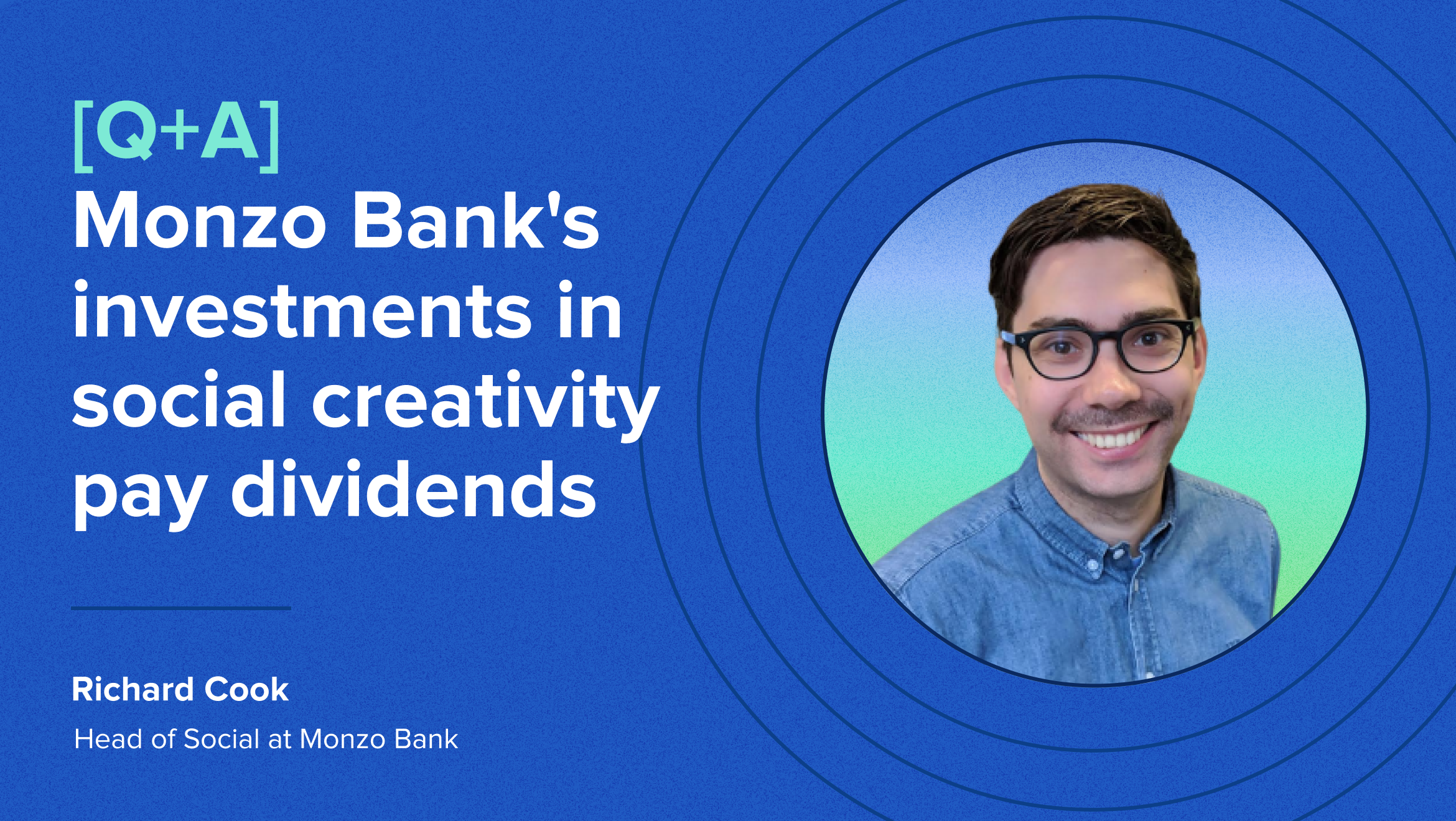Monzo Bank’s investments in social media creativity pay dividends

“For media and retail brands, going viral is easy. But there isn’t a built-in fan base for the finance sector,” asserts Monzo Bank’s Head of Social, Richard Cook.
The challenge Cook references is well-known to financial services marketers. Educating consumers about money can come with a steep learning curve. Factor in cultural taboos about personal finances and strict industry regulations, and delivering a winning social media strategy can seem impossible.
Yet, Monzo Bank stands out for their exceptional social presence. Not just for a financial brand, but among all brands. With nearly 1 million followers across platforms, Monzo has earned a loyal and impressive following. Their relatable, relevant and often irreverent tone proves that the limitations financial services face actually create the greatest opportunities for creativity on social.
I asked Cook for more details about what it took for Monzo to become a leading brand with a dedicated community, and the role social plays in the future of the financial services industry.
Financial organizations often see social media as a legal liability. How do you overcome regulatory concerns?
For good reason, banks can’t say whatever we want—especially when it comes to irresponsible, misleading or unclear financial advice. Deceptive marketing schemes are unethical and deeply harmful.
But that’s why working in social in a regulated industry comes with its own challenges. There are many specific laws (and punishable criminal offenses) marketers at financial services brands must consider. In the UK, the Financial Conduct Authority (FCA) passes down firm guidance for social media communications. They have specific guidelines that dictate everything from what you can show in graphics to how disclaimers must appear in content. This can be daunting for some brands—some even use regulations to justify not investing in social at all.
At Monzo, we see this as a tremendous opportunity. We view the legal redlines as helpful parameters that define our creative strategy. We even have internal documentation that outlines what different topics require from a regulatory perspective.
For example, we know that posting about investments requires extensive disclaimers and legal review. Consumers don’t want to see or listen to terms and conditions. That doesn’t feel like native social content, and those posts are likely to flop and require lengthy internal reviews. So they’re not a regular part of our context mix.
Our content isn’t product-driven, it’s inspired by feelings and conversations about money everyday people have. Lifestyle-inspired posts aren’t regulated in the same way as financial advice, and we have full license to have fun.
People don’t scroll social to discover financial services product announcements. They want to be entertained. We create content that puts our audience—rather than our product—first. Which also makes it easier to reduce time spent on stakeholder review.
Monzo’s presence is so fun, which is something people don’t usually say about banks. How did you make the case to leadership to develop such a distinct brand voice?
We’re lucky. The Monzo brand voice (on social and beyond) is rooted in simple, clear and human language. We’ve all gotten those letters from our bank that are so complex, it’s impossible to understand what they mean. We don’t have to speak like robots to talk about money. We don’t have to use weird passive voice. We can talk the way we talk to our friends.
Money is already an awkward topic for many people. Using condescending or confusing language just makes it even less accessible and more daunting. By shifting the language, we can change the culture around money.
Beyond that, I’ve also made it clear to leadership that social isn’t the place to talk about our product. There are exceptions, but we have certain thresholds. Is this product announcement cool or exciting? Are people on social going to care about it? A lot of traditional marketing doesn’t have a place on social—it’s better suited to our website, blog, email or other channels.
I made the case internally that social is a brand-building tool. Once that clicked across marketing (and the entire company), everything made sense to stakeholders. It wasn’t about literally talking about our brand, it was about showing our audience that we understood them. Brand-building on social is really just holding up a mirror to your audience. To do that, we also had to sound like our audience.
We do get the one-off questions about why we post certain unhinged memes, but use those opportunities to educate about social and online culture.
How does community engagement factor into your approach?
About seven years ago when I started at Monzo, we were an up-and-coming company and social culture was different. We primarily used it as a broadcast channel, amplifying all of our product news, updates and launches.
But now that we’ve established ourselves and built a community, we’ve pivoted to an engagement model. Which means that we’re always reading the comments, initiating conversations and conducting a lot of social listening to inform content. The comment section is our brief. Though it’s almost a cliché in the social industry, it’s true. Our engagement model is actually what helped us realize people had started using “Monzo” as a verb—a signal of how ubiquitous our brand was becoming online.
We aren’t afraid to talk about the pain points we uncover, even if we have to stray from brand guidelines to do so. Like when we saw that our signup selfie video was generating social buzz. It’s an awkward (but required) part of opening up an account with us. Instead of running away from it, we turned the relatable moment into content.
It’s also important to remember that you should connect with your audiences differently across channels. On LinkedIn, we talk a lot about relatable office moments (instead of money). We never really post about the product there, but we do talk about co-workers using the microwave in the break room. We even have a Greg at Monzo account, a faceless brand character helping us build our brand universe. Though LinkedIn might seem like an unexpected platform for a bank, it’s our most experimental channel where we also have the most followers.
All of this content reflects the behaviors and feelings of our audience. Our social strategy is to prove our brand proposition that our products get you. That’s the throughline from our core brand to the unconventional things we’re doing across social platforms.
What does your team structure look like, and how does it empower you to think creatively and move at the speed of social?
At Monzo, we have a relatively small, three-person team. As the Social Lead, my primary responsibilities include strategy, reporting and social listening. Our senior social media manager crafts our daily content calendar and briefs, leads brainstorms and manages our community. Our in-house content creator is dedicated exclusively to video content creation on TikTok, Reels and YouTube Shorts. We also work closely with collaborators outside of the social team, including our brand designer and creator manager.
Despite our small size, our scrappy team typically posts 20 times per week. We typically try to build our content calendar about two weeks in advance. We plan around major moments, like holidays and cultural touchstones. For inspiration, we look at other brands—not in our industry—who have cracked the code for reaching their audiences in fun, engaging ways.
Though trends are important on social, they can be a false friend. We want to understand them, but we try to resist the temptation to jump on every one. Social users are getting fatigued—they remember the trend, not the brands that participated in them. We try to resist jumping on the bandwagon, instead opting for ways to impact culture. Our ambition is to start trends rather than follow them. We ask: How can we become the brand that other brands look to? We look at what we have in our brand toolkit, and brainstorm about where it could take us.
Our engagement, audience-focused approach means most of our content doesn’t require approval outside of our team because there’s minimal risk. Cross-functional partners trust us to post memes, for example. When we launch bigger campaigns connected to major moments like product launches, we cascade content across an approval chain that includes our compliance, product and brand teams. But that content isn’t the core of our strategy. Agility in the financial sector necessitates thinking beyond product, and focusing on showing up in a truly social-first way.
Looking for more on how to build a social-first strategy as a financial services brand? Read our complete guide to social for financial services, and connect with other financial industry marketers in The Arboretum’s Financial Services Hub.











Share